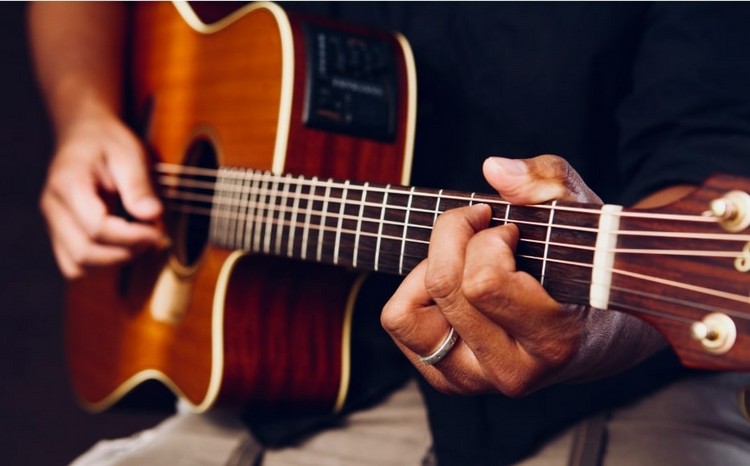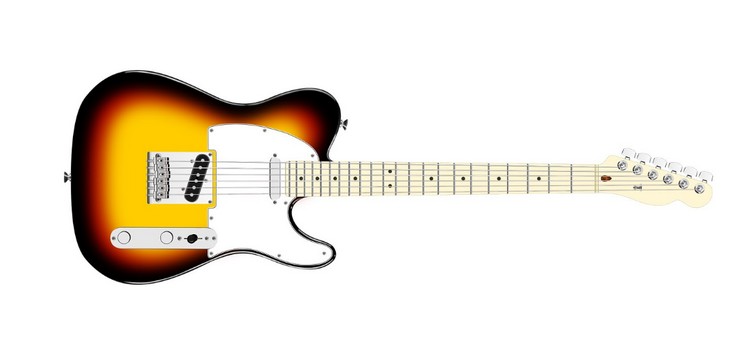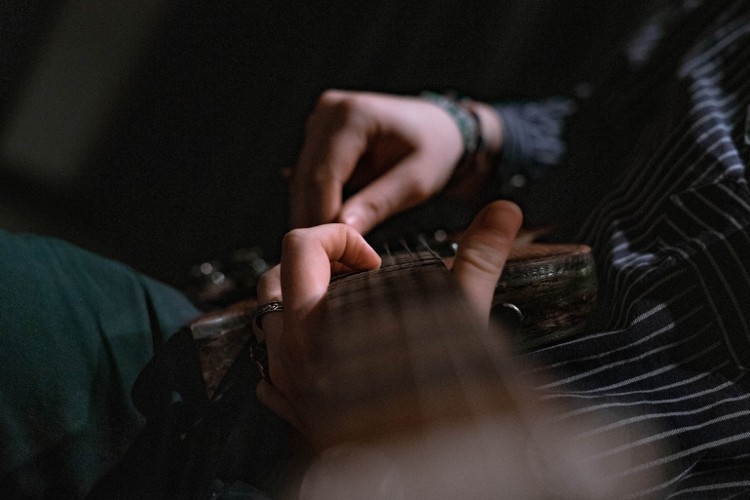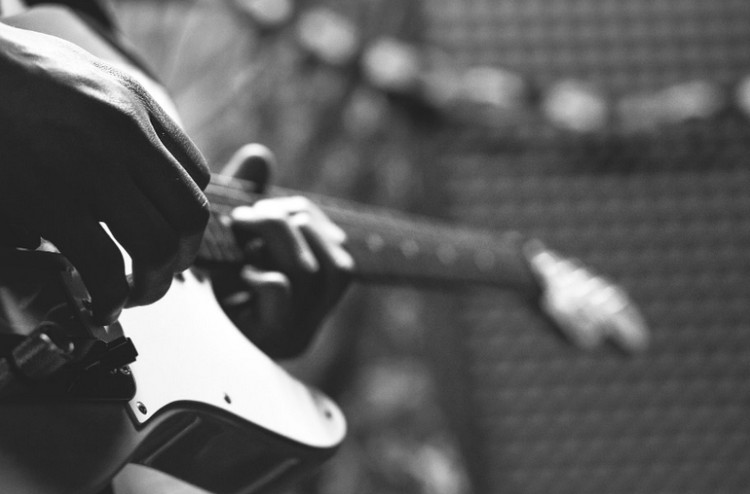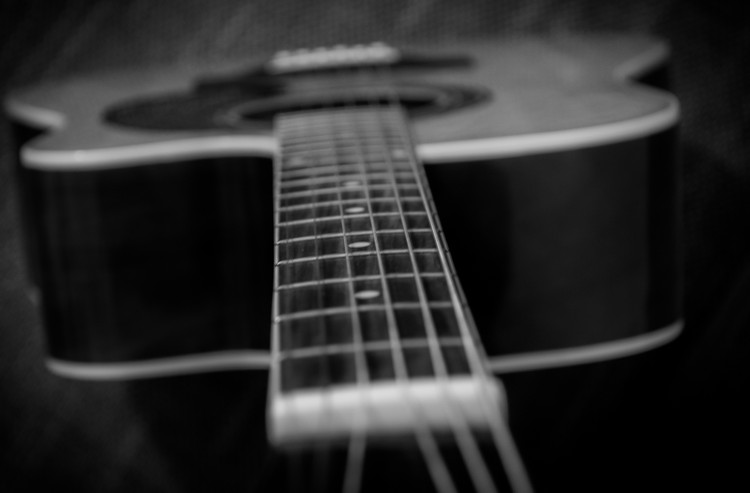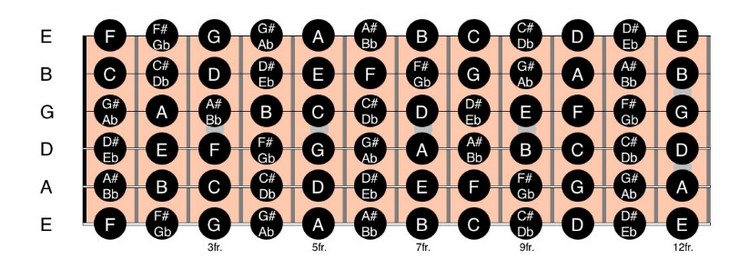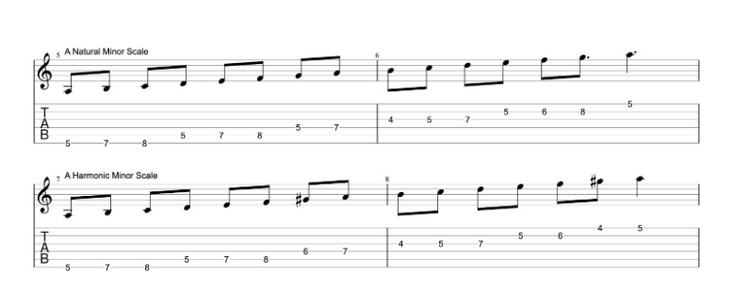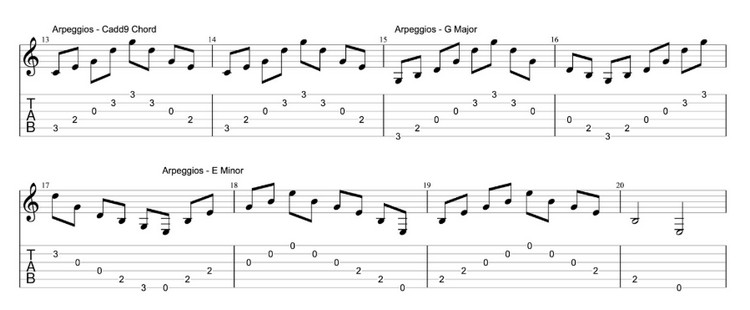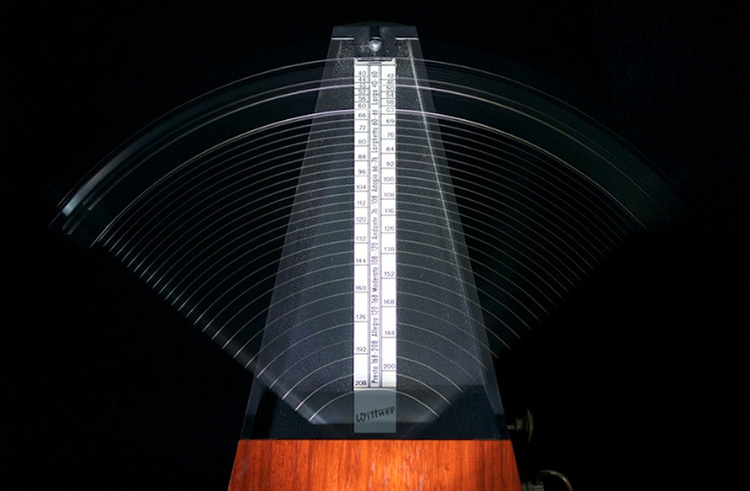At some point, every guitarist has to start learning the fretboard – let’s get you started today!
In this free lesson you will learn…
Over 100,000 guitar-learners get our world-class guitar tips & tutorials sent straight to their inbox: Click here to join them
- How to practice for better fret memorization
- How to practice chords to better learn the fretboard
- The chromatic scale & how to play it
- How scales are constructed
- What the musical alphabet is & how to learn it
Learning The Fretboard Can Feel Like An Overwhelming Task
The neck of the guitar is a musical universe all its own, and it can be difficult to navigate at first. Every guitarist arrives at the point of needing to learn the layout of the fretboard at a different stage of their journey.
For some, learning the fretboard is one of the first tasks they may accomplish – especially for those who are classically trained.
For others, this comes at a much later stage.
Whatever our skill level, we all arrive at a point where our knowledge of the frets begins to limit our playing, and we need to dive deep in order to understand more about what we’re playing and where.
We’re here to tie your knowledge together and apply it to that plank of wood and metal strings we all love so much. Learning the fretboard doesn’t have to be as daunting as it initially seems.
You’re about to have some serious breakthroughs, so get stoked!
Pro Tip: We’re going to be discussing a fair bit of music theory today, so grab a pencil and paper before you dive in.
All set? Let’s go.
What Is Involved In Learning The Fretboard?
This is a long process, but not an intimidating one.
A large part of understanding the layout of our fretboard is identifying the patterns that occur across it.
These patterns happen in the form of scales and chords.
The more educated we are on these concepts, the easier it will be to understand the fretboard in the long run.
A few key principles that we can take into consideration for learning the fretboard are:
- The key of a barre chord can be moved simply by shifting the whole hand position up or down any series of frets
- Scale shapes function the same way
- Any riff can be ‘transposed’ (moved) up or down the fretboard into a different key
When learning the fretboard, it’s important to recall everything that we have learned up until this point and apply it to the knowledge we gain in this guide.
- Applying new concepts to old knowledge helps keep things consistent and cohesive in our brains.
- It also helps us rationalize the musical ideas we experience at every level of musical skill.
Pro Tip: At the end of this guide, go back through old lesson sheets you might have (or other lessons on in our library) and apply these concepts to everything you know.
You’ll be surprised by how well the pieces begin to fit together.
To start with, let’s break down what we call The Musical Alphabet.
Learn 12 EASY beginner chords with our popular guide

✅ Stop struggling. Start making music.
✅ Learn beginner-friendly versions of every chord.
This is our most popular guide and it will improve your chord ability quickly! 😎
Get your own personalised guitar-learning plan 🎸
Get a custom guitar-learning plan here: Click here for GuitarMetrics™
World-Class Guitar Courses 🌎
Learn from the world's best guitar educators: Click here for our guitar courses
Learning The Fretboard: The Musical Alphabet
Western music as a whole primarily consists of twelve notes.
That’s right – Twelve. That’s all.
- If it sounds like there are more than twelve notes at play on the guitar, it’s because this instrument can play these notes in multiple octaves.
- At the end of the day however, twelve is the magic number of music.
The amount of different combinations for these twelve notes is absolutely endless, and it’s one of the many fascinating things about music.
Learning the fretboard can unlock the world of potential that lies within your instrument, and help you learn to speak the language of music theory in the process.
Let’s have a look at our twelve notes:
A A# B C C# D D# E F F# G G#
Bb Db Eb Gb Ab
Pro Tip: Did you notice that the sharp (#) notes have another set of notes underneath them? (b)
- This is because sharp notes have two names, and use one or the other depending upon their context.
- This b symbol is called a Flat, and both these and the Sharps are referred to as ‘Accidentals.’
- Accidentals are referred to this way to distinguish themselves from natural notes like A, B, C and D.
Many scales and chords contain accidentals, with C major and A minor being the only keys that do not. These distinctions are important to make when learning the fretboard practically.
Let’s talk a bit more about accidentals below.
Learning The Fretboard: Sharps & Flats Are The Same!
Musical context is a very important thing to understand when learning the fretboard.
In some instances when we talk about accidentals, it may be easier to refer to them as either ‘sharps’ or ‘flats’ depending upon the scale we are discussing.
If we are speaking about the fretboard with notes in no particular way or order, we can use either ‘sharp’ or ‘flat’ without preference.
In the context of scales and chords however, one is advisable over the other.
For example: When discussing a chord like Cminadd9 (C, Eb, G and D), we must use a flat symbol for the E. This is because there is already a D note within the chord, and therefore using a D# is not possible.
You cannot have two of the same note name within a chord or a scale, and that is why sharps and flats exist together.
- When learning scales and chords, this distinction is an important one to make.
- Adapting this principle now will help us further down the line when learning the fretboard.
Music theory can often be overlooked as an unnecessary component of the process of learning the fretboard.
The fact of the matter, however is that learning these principles of music theory can help us not only advance our playing, but our musical language as well.
- Every principle that we learn in turn affects our musicality and the way we speak with music.
- Learn a little bit of everything and you’ll have a well-rounded approach to your instrument.
Have a look at the fretboard below to see all the spots where ‘accidentals’ occur:
Learning The Fretboard: Movable Chord Shapes
One of the most crucial chord formations to learn are barre chords.
These are what are known as ‘movable shapes,’ meaning their whole chord formation can be shifted into a different key simply by moving it around the fretboard.
These types of chord shapes are fantastic teachers of chord structure, and fantastic for learning the fretboard fluently.
As we move a barre chord shape into a different key (ex. From Fmajor to A major [1st fret to 5th fret]) we should take the time to explore what notes are being played.
Here are a few examples of barre chord shapes that can be moved around the fretboard:
This same rule applies to partial barre chords – chords that require us to barre with our index finger but not across six strings.
- These shapes can also be shifted around the fretboard.
- Each chord type has its own set of shapes that we can play with around the fretboard.
- Take the time to learn each different chord’s structure and play it in various positions while learning the fretboard.
- The more we commit to learning chord shapes and structures, the more well-versed we will become not just as guitarists, but musicians as well.
Learning The Fretboard: How Scales Are Built
Scales are similar to chords in that they are built out of many different combinations of notes.
When combined, these notes can create a wide variety of different tones.
The selection of notes is extremely important, and one note can make a world of difference in the tone of a scale.
For example, the natural minor scale contains seven notes and carries a dark and neutral tone. The harmonic minor scale contains all of the same notes as the natural minor scale, except the 7th note is sharpened (#).
- This may not seem like a big change, but that one-note difference creates an entirely different tone by comparison.
- It also creates a different 7th chord in the scale, which changes the tone of the scale once again.
- Being aware of these tonal changes is crucial to properly learning the fretboard.
Scales are most often built in five-note structures (called ‘pentatonic scales’) and seven-note structures (called ‘diatonic scales’).
These types of scales both have their respective uses in a variety of different genres, but each has their own distinct character in each of the twelve keys of music.
Pro Tip: When learning the fretboard, it’s important to practice scales in multiple fret positions to gain an understanding of how notes are shared throughout the keys.
- For example: C major and G major share the exact same set of notes, apart from F.
- In C major, the F is natural (meaning not sharp or flat). In G major, the F is sharp (#).
- These subtle differences make learning music theory much easier, so pay attention to what notes occur where.
Download our lead guitar cheat-sheet to make things easier
It's hard to understand which scales work with which keys.
So we created a cheat-sheet! A key and scale-finder that you can use again and again.

Get your personalised guitar-learning plan 🎸
Get a custom guitar-learning plan here: Click here for GuitarMetrics™
World-Class Guitar Courses 🌎
Learn from the world's best guitar educators: Click here for our guitar courses
Learning The Fretboard: Arpeggios
Arpeggios are one of the things that can tie our scale and chord knowledge together quite well when learning the fretboard.
An arpeggio is simply the act of playing a chord’s notes individually rather than all at once.
This helps us with a number of things:
- Ear training (to hear the notes individually and hear the character of the chord)
- Clarity (Arpeggios help check if we have accidentally muted any strings when playing a chord)
- Breaking down the notes inside each chord individually
Arpeggios are great tools for learning the fretboard, as they force us to take a closer look at what we’re playing.
We’ve included a few deconstructed chords below for you to play through – Give it a shot!
When playing barre chords, playing them as an arpeggio can also lead to some pretty cool lead guitar sounds.
Pro Tip: Arpeggios help us sound out the inner voice of each chord. As such, it’s a great idea to arpeggiate new chords as we learn them to get a better understanding of how they work.
- Arpeggios also serve as great voicing techniques for lead guitarists. If you’re ever struggling with what to play over a chord progression, just play the arpeggios of the chords themselves!
- One of the best approaches to learning the fretboard is playing arpeggios of every chord you know. You’d be surprised at the potential it opens up!
Click here to listen to Yngwie Malmsteen play through his “Arpeggios From Hell” guitar DVD on YouTube, and click here to watch Charlie Robbins shred through his arpeggio-fueled adventure ‘Spicy.’
Practice: The Chromatic Scale
As an additional piece of practice material for learning the fretboard inside and out, we want to take a look at the Chromatic scale.
This is a scale with essentially zero natural melodic content on its own.
Translation: It doesn’t sound great.
- The advantage that the chromatic scale gives us however, is that it shows us all of the notes in sequence, and often in one position.
- The version of this scale that we have included below starts in the open position and uses the first four frets of the guitar.
- Assign each of your fingers to each of the first four frets in order, and focus on alternate picking to keep the sound smooth and clear.
- Take it slow and steady!
Pro Tip: The chromatic scale can be played anywhere on the fretboard. This isn’t typically a scale that you would use when soloing, and it technically has no root note.
This scale is used more for exercising the fingers and learning the fretboard, as well as practicing general navigation techniques across the guitar.
Getting used to the sound of all of the notes against one another also helps to improve our ear, so don’t discount this scale’s ability to improve both your playing and your ears!
Super Pro Tip: Practice the chromatic scale to a metronome.
- This is quite possibly the best way to improve your playing and focus on learning the fretboard at once.
- Set the metronome to 100bpm (beats per minute) and play two notes per beat.
- This involves patience and some practice, but you’ll nail it if you keep at it.
- Practicing this scale (and every other scale) in this way helps us pace ourselves.
- Focusing on alternate picking here will keep us sounding smooth as ice.
Google has a metronome embedded if you search “metronome.” Easy, right?
Where Do I Go From Here?
If you aren’t yet finished learning the fretboard, here are a few other things we recommend putting into practice:
- Pick up a copy of Fretboard Mastery by Troy Stetina
- Practice saying the notes of the fretboard out loud as you play through the Chromatic scale.
- Learn scales to improve your knowledge of the fretboard
- Learn some new chords
- Put your vast array of musical knowledge to work and write a song!
Recommended Resources
If you enjoyed reading this article about learning the fretboard as much as we enjoyed writing it, then you’ll love some of our other lessons below!
- How to Tune A Guitar
- Capo Chart
- Barre Chords: The Ultimate Guide
- Guitar Arpeggios: The Ultimate Guide
- Guitar Chords: The Ultimate Guide
What Type of Guitarist Are You?
Take our 60-second quiz & get your results: Take The Quiz
Join the world's best online guitar school 🌎
- Get your own personalised guitar learning plan (customised just for YOU).
- World-class online guitar courses. Learn at your own pace.
- Community Campus & Learning Forum - A friendly community! Connect with our team & students. 😊
- Beginner Song library with chordsheets, tabs and tips. (Songs suitable for all levels!)
- Regular live streams, seminars and Q&A sessions - Learn from world-class guitar educators. Get all your questions answered!
Click here to learn more about National Guitar Academy membership 
Cool Guitar T-shirts 😎
Look cooler! Check out our merch: Click here to see our merch store
Want free guitar tips and video lessons delivered to your inbox?
Join over 100,000 guitar-learners and subscribe to our guitar-tips-by-email service. (It's free.)
We'll send you a series of lessons that will move you to the next level of your guitar journey.
Learn how everything fits together quickly, easily and effectively. We share ninja tips (for instant fun!) but also timeless fundamentals that will deepen your understanding.

Popular Lessons
How To Learn Guitar: An 11-Step Programme For Beginners
How To Choose The Perfect Beginner Guitar
More Cool Guitar Stuff
Learn about National Guitar Academy: About Us
Join us on Facebook for daily guitar tips.
Listen to our Learn Guitar Podcast for rapid guitar progress.
Check out our free chord lessons.
Get our best guitar tips & videos
Where should we send it?
Where should we send it?
Get our best guitar tips & videos

